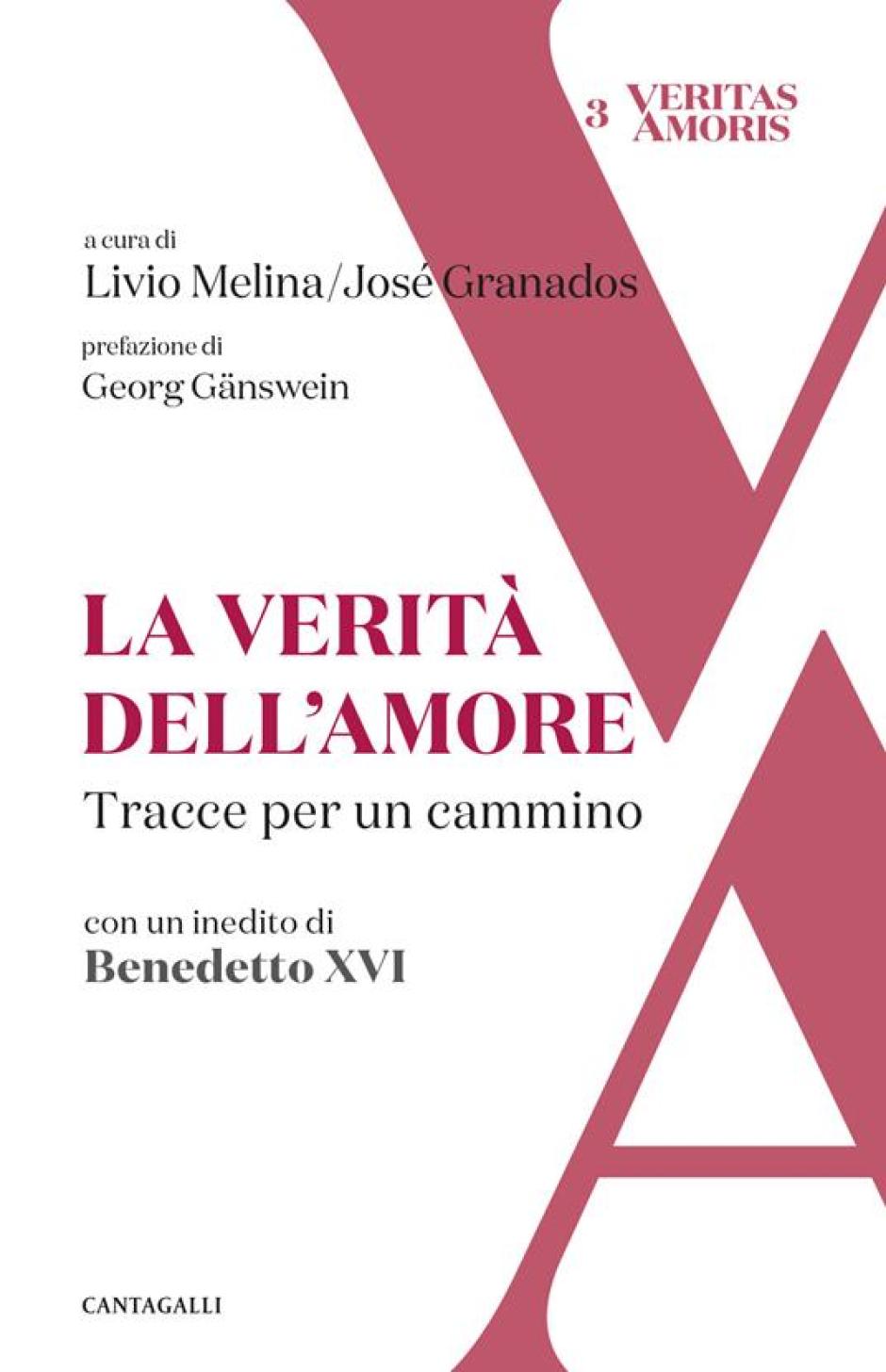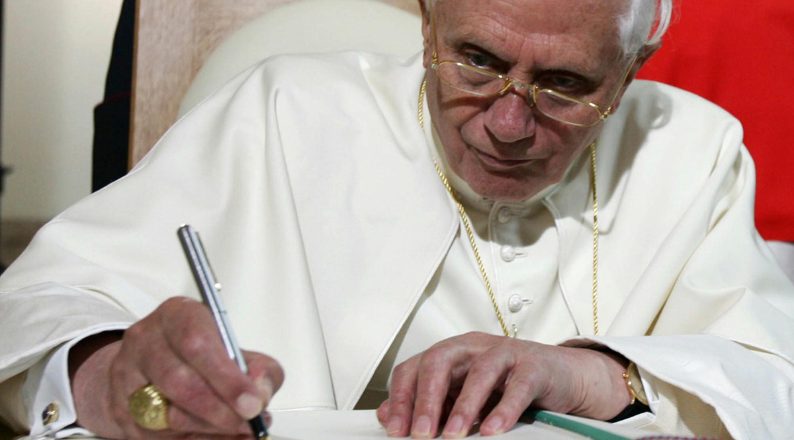(ZENIT News / Rome, 22.10.2024).- An unpublished document of Pope Emeritus Benedict XVI, titled “The Christian Image of Man,” reveals a profound reflection on the moral and social problems that contemporary humanity is facing. This text, written between Christmas and Epiphany of 2019-2020, addresses with special attention the crisis of identity, the family and human love, subjects that for the Pope Emeritus are essential in the quest for a more coherent future with the dignity of the human being.
The publication was carried out by the “Veritas Amoris Project,” founded in 2019, with the objective of continuing the work of the John Paul II Institute for Studies on Marriage and the Family. Benedict XVI’s text appears in the third volume of the Italian Review of the project, a space that seeks to trace ways to the truth of love amid a world in constant transformation.
One of the most salient points of the writing is the Pope Emeritus’ criticism of today’s ideological currents, such as gender ideology and the manipulation of life in laboratories. According to Benedict XVI, these tendencies are the fruit of a Marxism disguised as extreme liberalism, which has deformed the concept of freedom and threatens to undermine the essence of what it means to be human. Through his words, the Pope Emeritus seeks to stress that truth without love becomes cold, and that it is in the combination of both where hope lies in a more just and human society.
This last intellectual legacy of Benedict XVI not only invites to profound reflection on the most urgent questions of our time, but it also leaves a clear warning: humanity must find a balance between progress and the preservation of its nature, or run the risk of losing itself in the confusion of modern times. Following is an English translation of the article.
* * *
“The Christian Image of Man”
By Benedict XVI
(Published originally here in Italian)
The atmosphere that spread widely in Catholic Christianity after Vatican Council II was initially conceived in a unilateral manner as a demolition of walls, as “tear down the fortresses,” in such a way that in certain circles the fear began of the end of Catholicism, or also to expect it joyfully.
Paul VI’s firm determination and John Paul II’s equally clear and happily open one, were able to ensure to the Church again — speaking humanly — her own space in future history. When John Paul II, who came from a country dominated by Marxism, was elected Pope, some thought that a Pope who came from a Socialist country would necessarily be a Socialist Pope and, hence, would carry out the reconciliation of the world as a “reductio ad unum” of Christianity and Marxism. The senselessness of this position became rapidly evident, as soon as it was seen that a Pope from a Socialist world knew perfectly well the injustices of that system, and it was thus that he was able to contribute to the surprising turn that occurred in 1989, with the end of the Marxist Government in Russia.
However, it became ever more evident that the decline of the Marxist regimes was far from having constituted a spiritual victory of Christianity. On the contrary, a radical secularization was revealed increasingly as the authentic dominant vision, increasingly depriving Christianity of its vital space.

From its beginnings, modernity began with the call to man’s freedom — from Luther’s emphasis on the Christian’s freedom and from the humanism of Erasmus of Rotterdam. However, it was only in the time of the historical troubles after two World Wars, when Marxism and Liberalism went to dramatic extremes, that two new Movements arose that took the idea of freedom to an unimaginable radicalism up to then.
In fact, now it is denied that man, as free being, is in some way linked to a nature that determines the space of his freedom. Man no longer has a nature, but he “makes” himself. A human nature no longer exists: it is he who decides what he is, man or woman. It is man that produces man and who thus decides the destiny of a being who no longer comes from the hand of a Creator God, but from the laboratory of human inventions. The abolition of the Creator like the abolition of man then became the genuine threat to faith. This is the great challenge that is presented today to Theology. And it will only be able to face it if Christians’ example of life is stronger than the power of the denials that surround us and promise us a false freedom.
The awareness of the impossibility of resolving a problem of this size solely at the theoretical level does not exempt us, however, from trying to propose a solution at the level of thought.
Nature and freedom seem, in the first instance, to be opposed in an irreconcilable way, however, the nature of man is thought, namely, it is creation and, as such, it is not simply a reality deprived of spirit, but has in itself the “Logos”. The Fathers of the Church – and in particular Athanasius of Alexandria – conceived creation as the coexistence of uncreated “sapientia” and created “sapientia”. Here we touch upon the mystery of Jesus Christ, who unites in Himself created and uncreated wisdom and who, as incarnate wisdom, calls us to be together with Him.
Thus, nature, which is given to man, is no longer distinct from the history of man’s freedom, and carries within itself two fundamental moments.
On the one hand, we are told that the human being, the man Adam, began his history badly from the beginning, in such a way that the fact of being human, the humanity of each one, carries within it an original defect. “Original sin” means that every individual action is previously inscribed in an erroneous way.
However, to this is added the figure of Jesus Christ, the new Adam, who paid in advance the redemption for all of us, thus offering a new beginning in history. This means that man’s nature is, in some way, sick, that it needs correction (“spoliate et vulnerate”). This places it in opposition to the spirit, to freedom, just as we experience it continually. However, in general terms, it is also redeemed now. And this in a twofold sense: because in general the sufficient has already been done for all sins and because, at the same time, this correction can always be given to each one in the Sacrament of Forgiveness.
On one hand, the history of man is the history of ever new failures; on the other hand, healing is always available. Man is a being who needs healing, forgiveness. The fact that this forgiveness exists as a reality and not only as a beautiful dream belongs to the heart of the Christian image of man. Here is where the doctrine of the Sacraments finds its just place. The necessity of Baptism and of Penance, of the Eucharist and the Priesthood, just like the Sacrament of Marriage.
It is from here that the question of the Christian image of man can then be addressed concretely. First of all, the observation expressed by Saint Francis of Sales is important: “one” image of man doesn’t exist, but many possibilities and many ways in which the image of man is presented: from Peter to Paul, from Francis to Thomas Aquinas, from Brother Konrad to Cardinal Newman, and thus successively, where there is undoubtedly a certain emphasis that speaks in favour of a predilection for the “little ones.”
Naturally, it would also be worth examining, in this context, the interaction between the “Torah” and the Sermon on the Mount, of which I have already talked about briefly in my book on Jesus.



